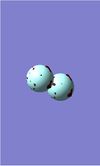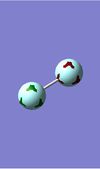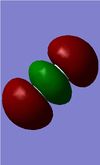IMM2js2016
NH3 molecule
Summary information
N-H bond length = 1.01798 Å
Corresponding literature value = 1.002 Å[1]
H-N-H bond angle = 105.741o
Corresponding literature value = 107.2o [1]
Calculation method: B3LYP
Basis set: 6-31G(d,p)
Symmetry: C3v
Final energy E(RB3LYP) = -56.5577687299 au
Item Value Threshold Converged? Maximum Force 0.000004 0.000450 YES RMS Force 0.000004 0.000300 YES Maximum Displacement 0.000072 0.001800 YES RMS Displacement 0.000035 0.001200 YES
NH3 molecule |
Frequency analysis
Mode # Freq Infrared 1 1089.54 145.3814 2 1693.95 13.5533 3 1693.95 13.5533 4 3461.29 1.0608 5 3589.82 0.2711 6 3589.82 0.2711
From the general equation 3N-6 = number of vibrational modes, ammonia is made up of four atoms (N=4) so 6 vibrational modes are expected. Our calculations fall in line with this prediction. From the table above, you can see that both modes 2 and 3, and 5 and 6 are the degenerate pairs. Modes 1, 2 and 3 are bending vibrations whilst modes 4, 5 and 6 are bond stretching vibrations. Mode 4 has highly symmetric vibrations and mode 1 is the 'umbrella' mode.
4 bands would be expected in an experimental spectrum of ammonia.
Charge on the nitrogen atom is -1.125 and charge on the hydrogen atom is 0.375. Nitrogen is more electronegative than hydrogen so nitrogen pulls the surrounding electrons closer to itself, hence nitrogen should have a negative value for atomic charge whilst the hydrogen atoms should have positive values.
N2 molecule
Summary information
Calculation method: B3LYP
Basis set: 6-31G(d,p)
Symmetry: D∞h
E(RB3LYP)= -109.52359111 au
Item Value Threshold Converged? Maximum Force 0.000001 0.000450 YES RMS Force 0.000001 0.000300 YES Maximum Displacement 0.000000 0.001800 YES RMS Displacement 0.000000 0.001200 YES
N2 molecule |
Frequency analysis
Mode # Freq Infrared 1 2457.33 0.0000
H2 molecule
Summary information
Calculation method: B3LYP
Basis set: 6-31G(d,p)
Symmetry: D∞h
E(RB3LYP)= -1.15928020 au
Item Value Threshold Converged? Maximum Force 0.000000 0.000450 YES RMS Force 0.000000 0.000300 YES Maximum Displacement 0.000000 0.001800 YES RMS Displacement 0.000001 0.001200 YES
H2 molecule |
Frequency analysis
Mode # Freq Infrared 1 4465.68 0.0000
Calculations for Haber-Bosch Process
E(NH3)= -56.55776873 au 2*E(NH3)= -113.11553746 au E(N2)= -109.52412868 au E(H2)= -1.17853936 au 3*E(H2)= -3.53561808 au ΔE=2*E(NH3)-[E(N2)+3*E(H2)]= -0.0557907 au = -146.47848285 kJ/mol
Since ΔE is negative, the product in this reaction must have a lower energy than the reactants. Therefore the ammonia product must be more stable than the gaseous reactants.
Project molecule (F2)
Summary information
Calculation method: B3LYP
Basis set: 6-31G(d,p)
Symmetry: D∞h
E(RB3LYP) = -199.42620785 au
Item Value Threshold Converged? Maximum Force 0.000128 0.000450 YES RMS Force 0.000128 0.000300 YES Maximum Displacement 0.000156 0.001800 YES RMS Displacement 0.000221 0.001200 YES
F2 molecule |
Frequency analysis
Mode # Freq Infrared 1 1065.09 0.0000
Since fluorine molecules are diatomic, the only mode of vibration is a bond stretching vibration. There are no atomic charges on either of the fluorine atoms because two atoms of the same element are covalently bonded together.
Molecular orbitals







